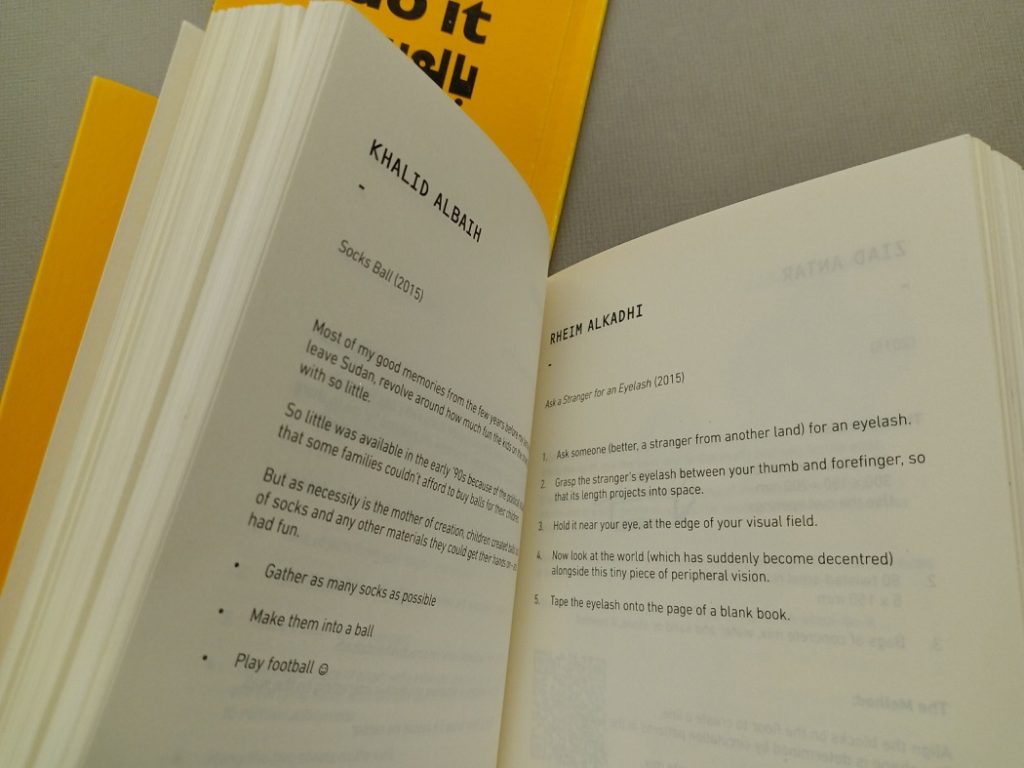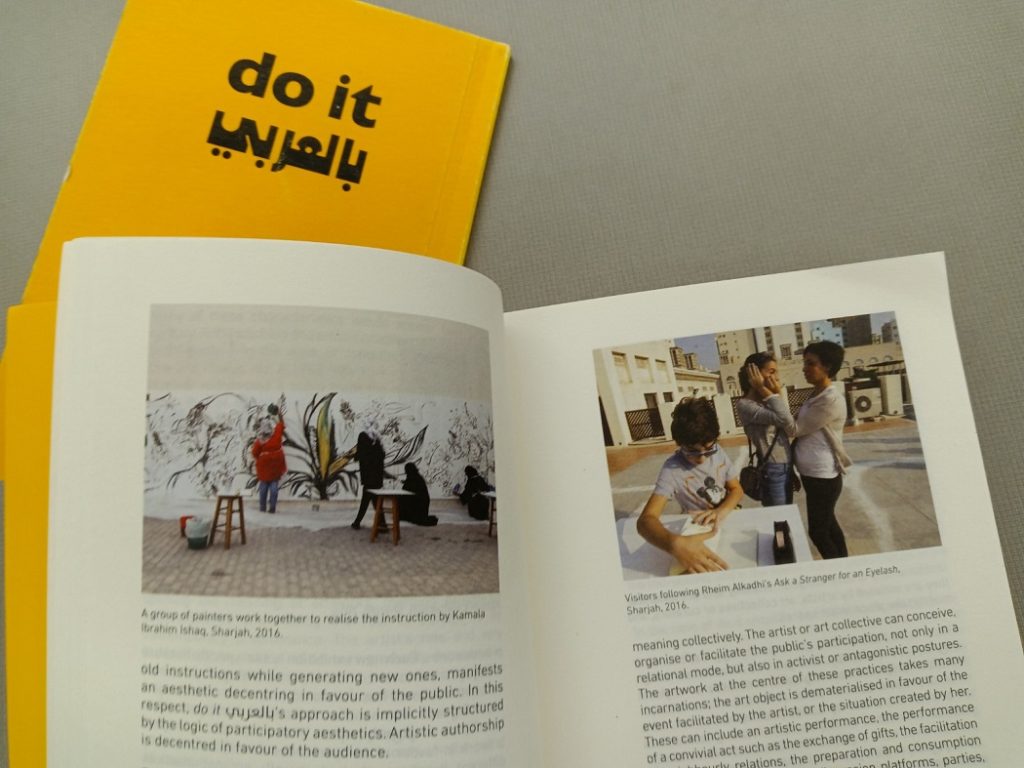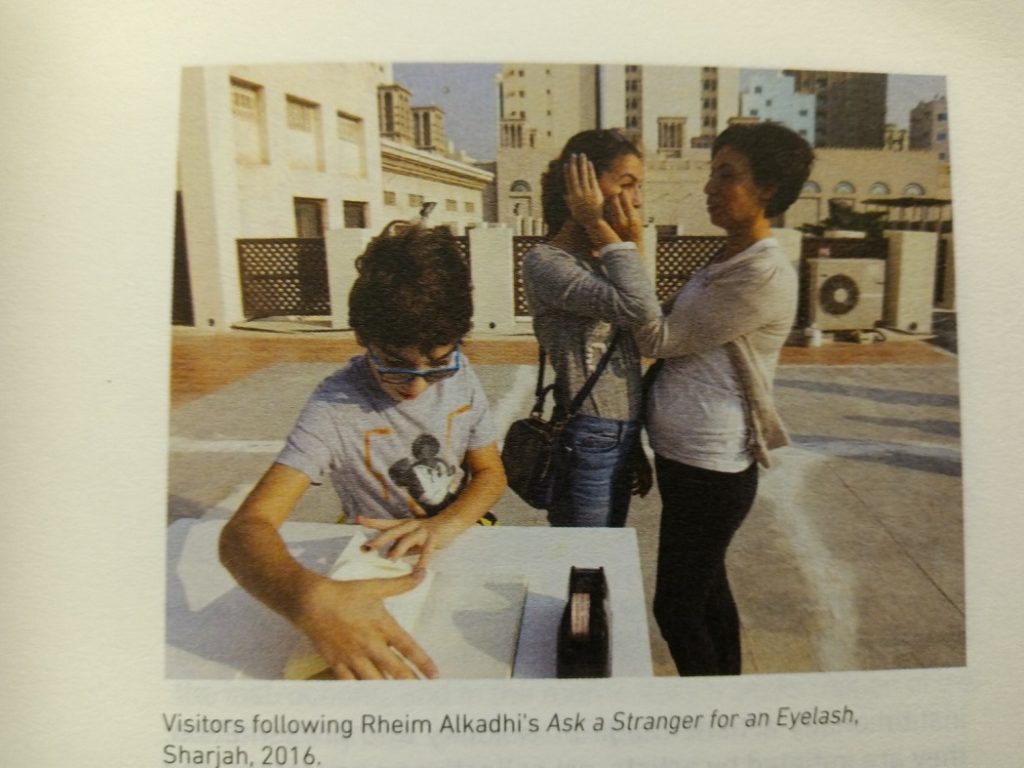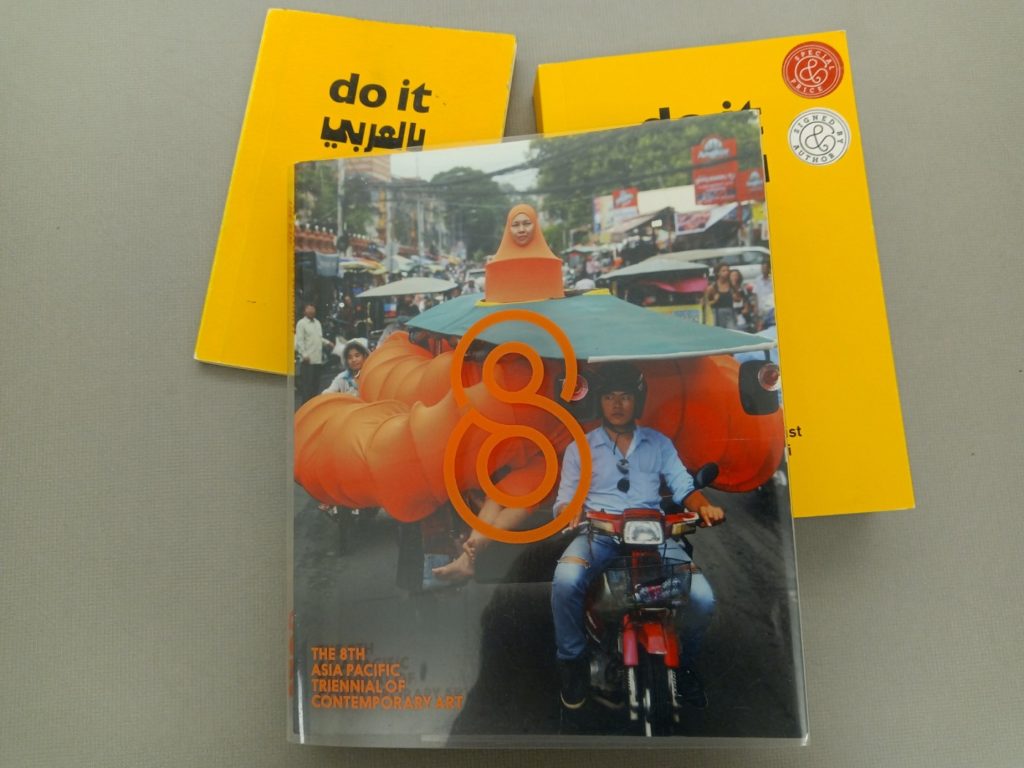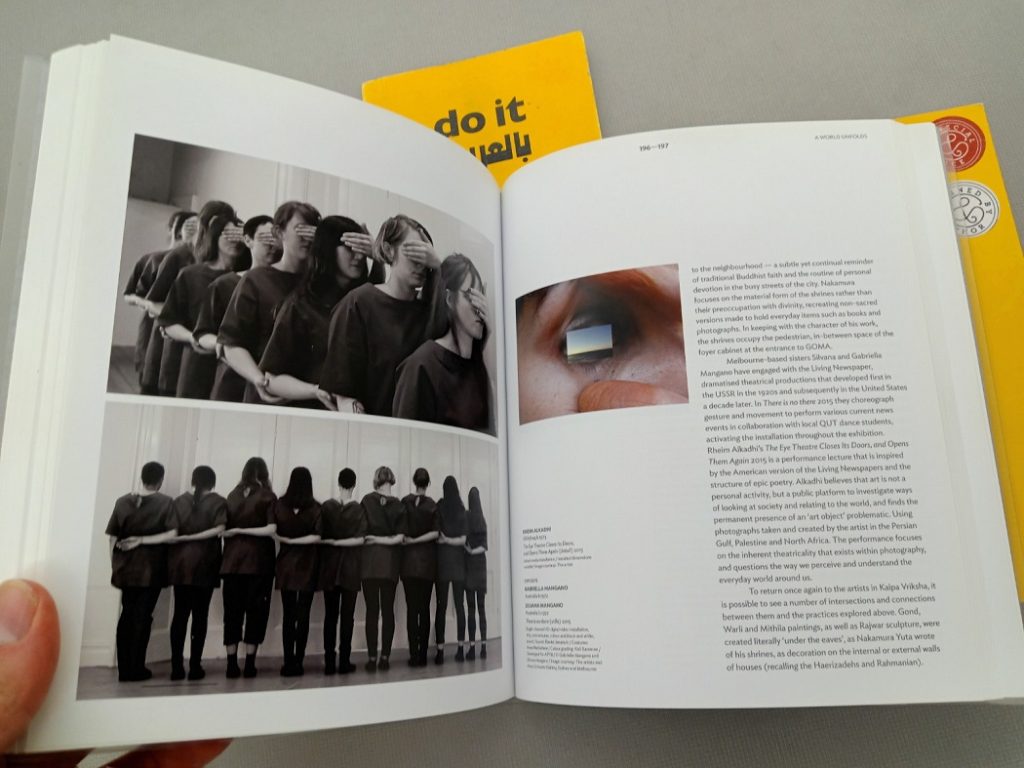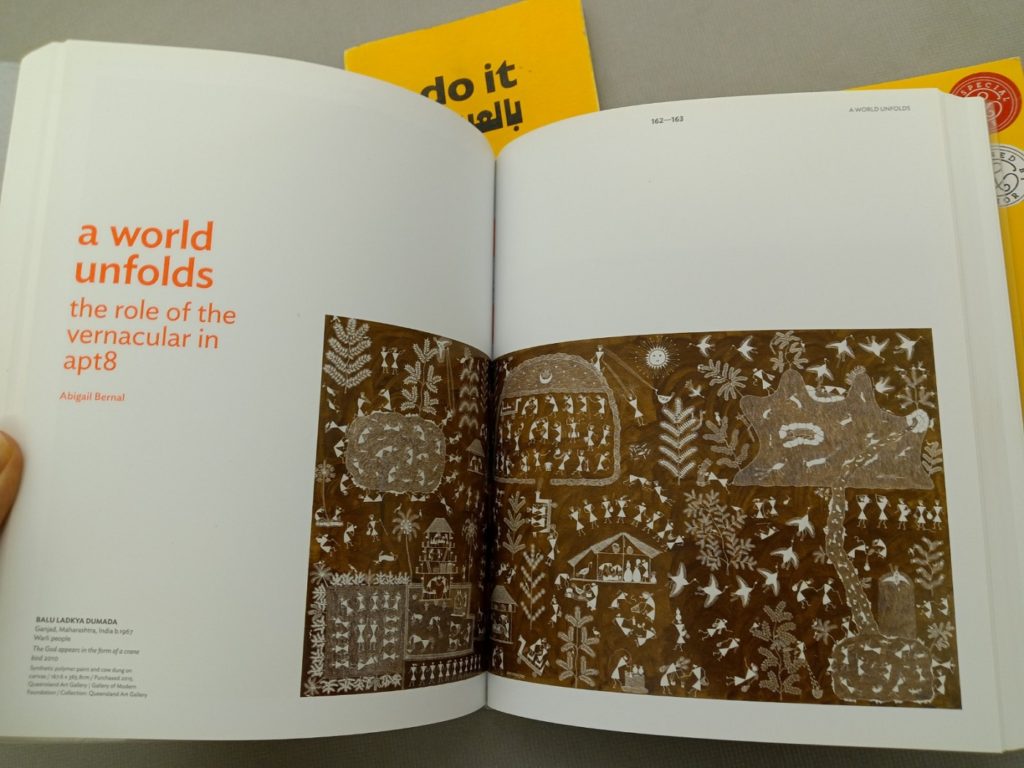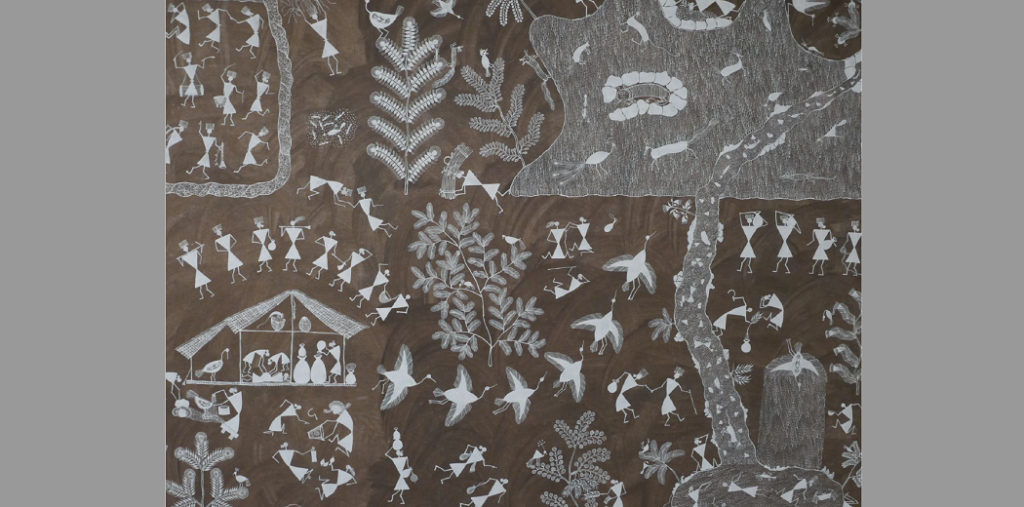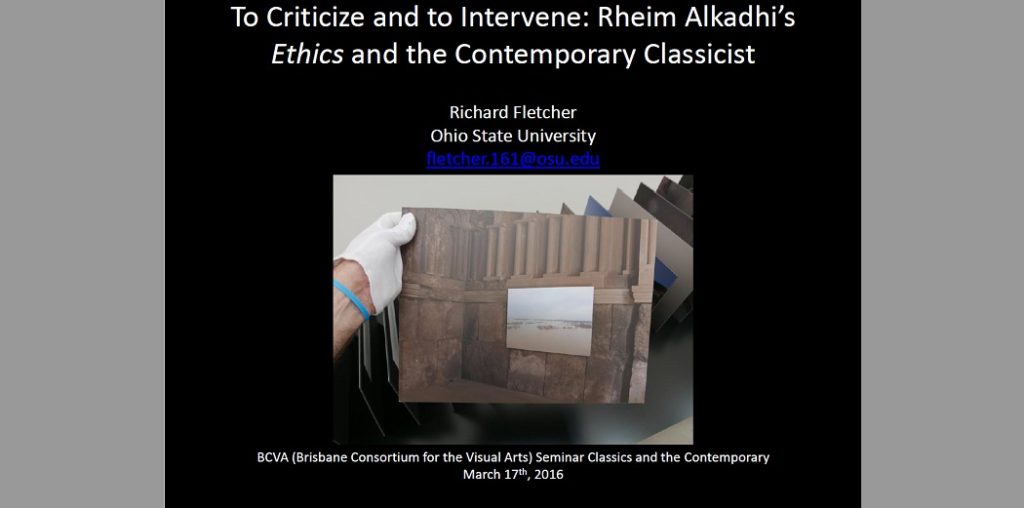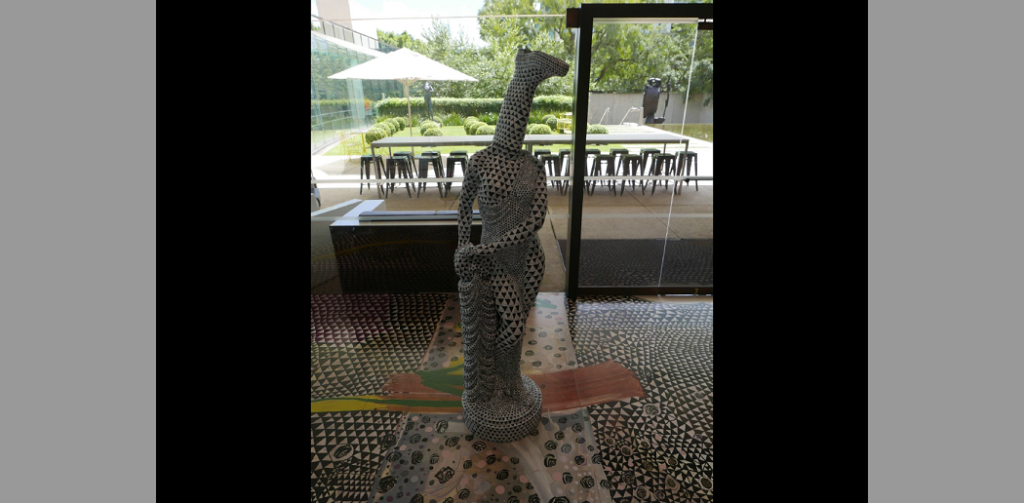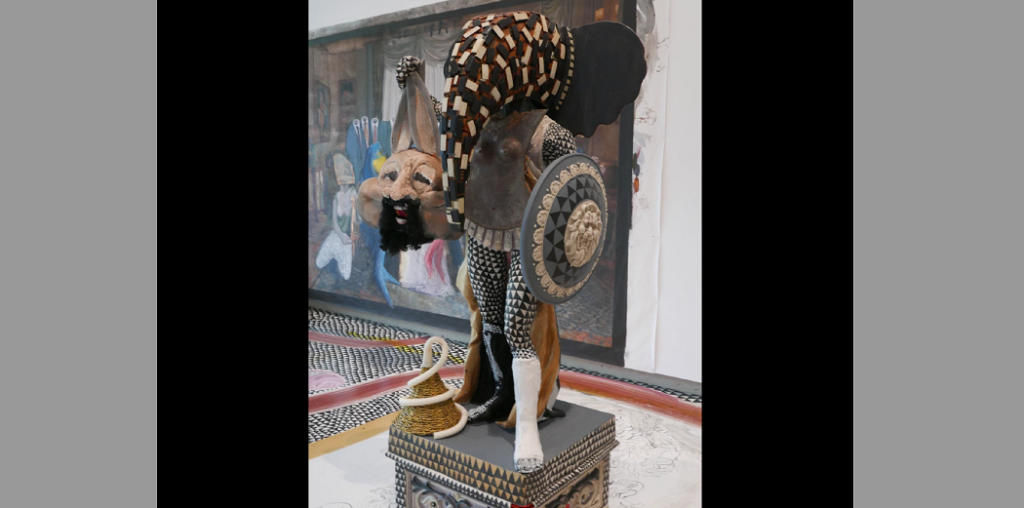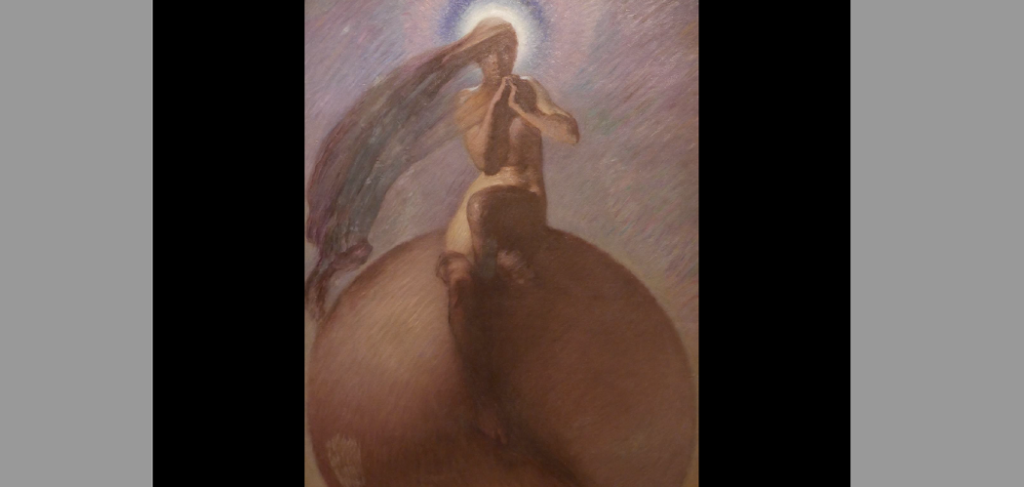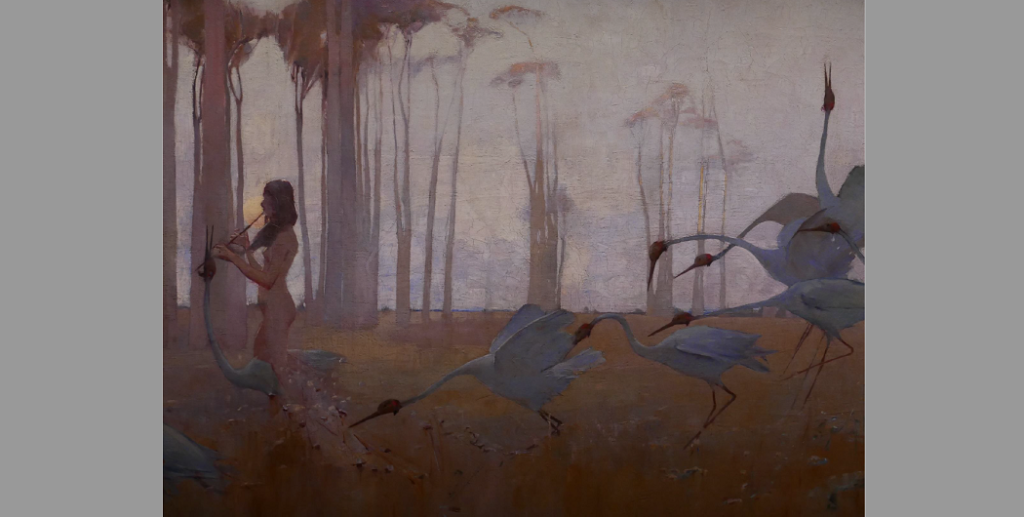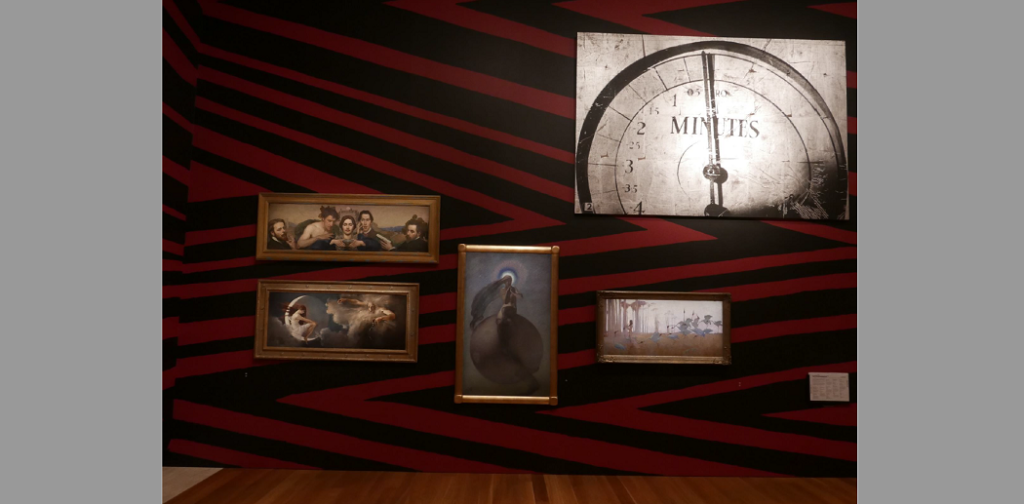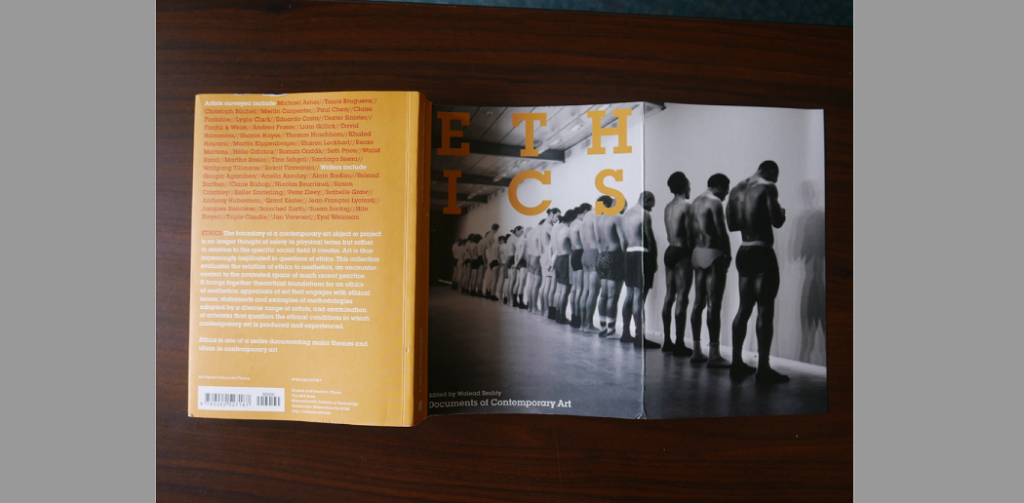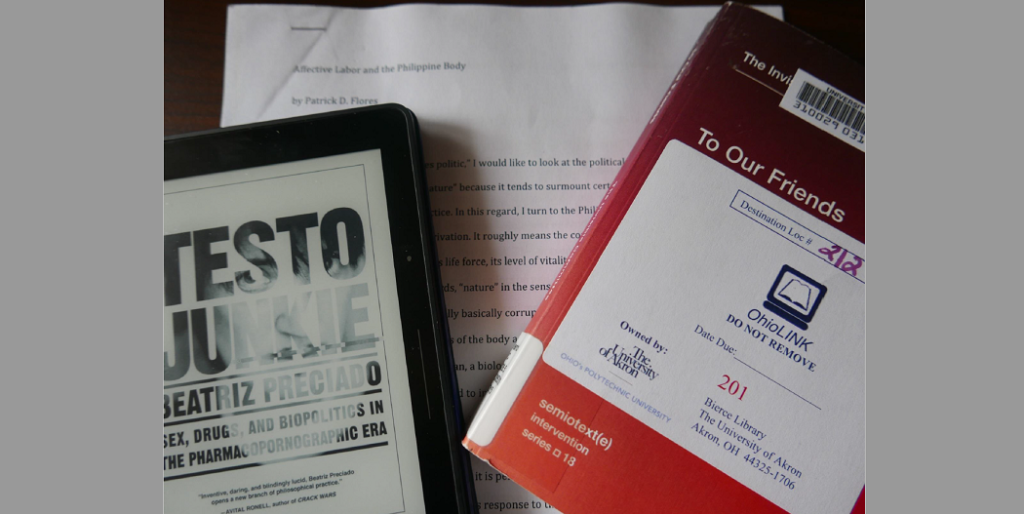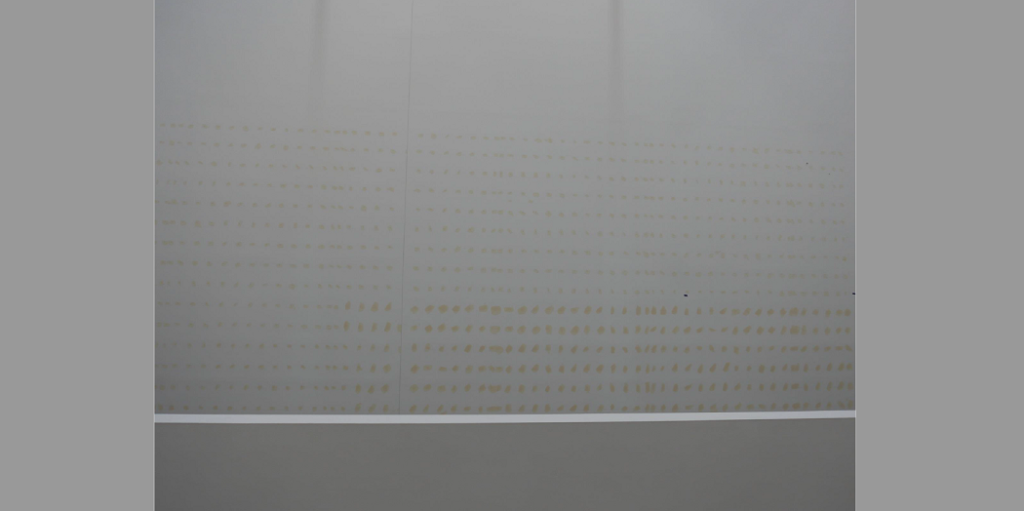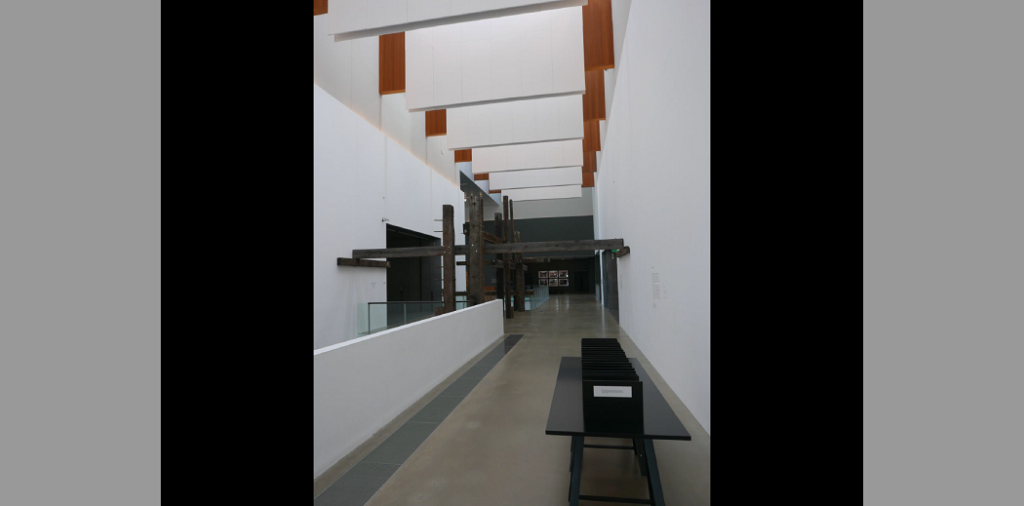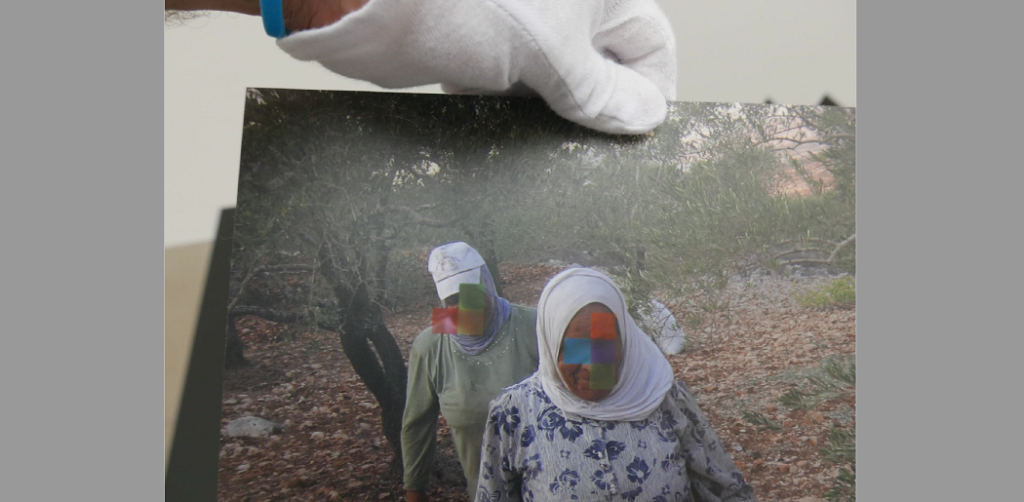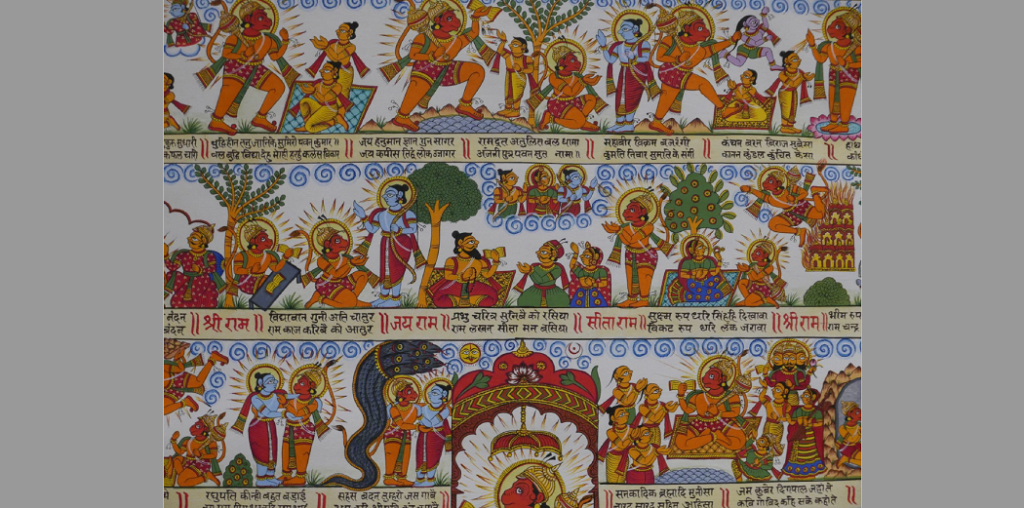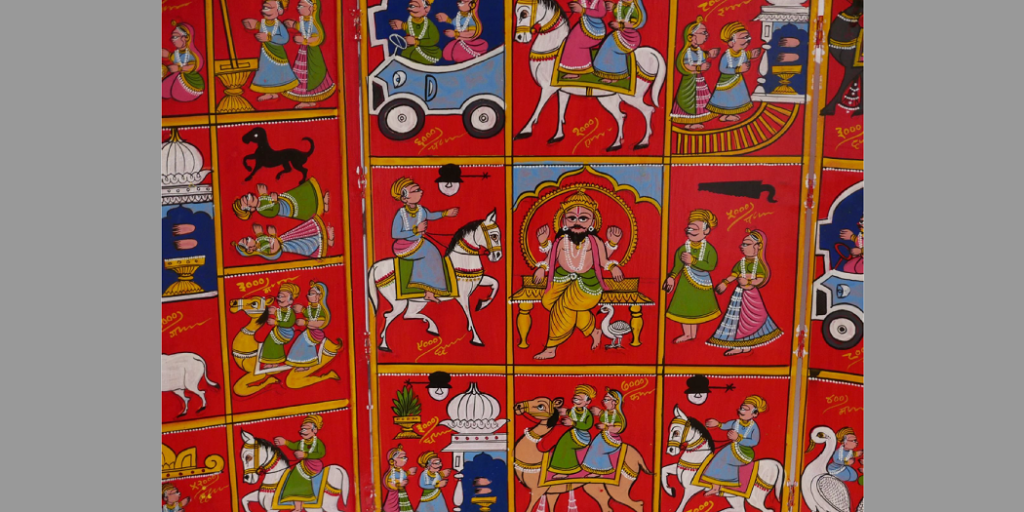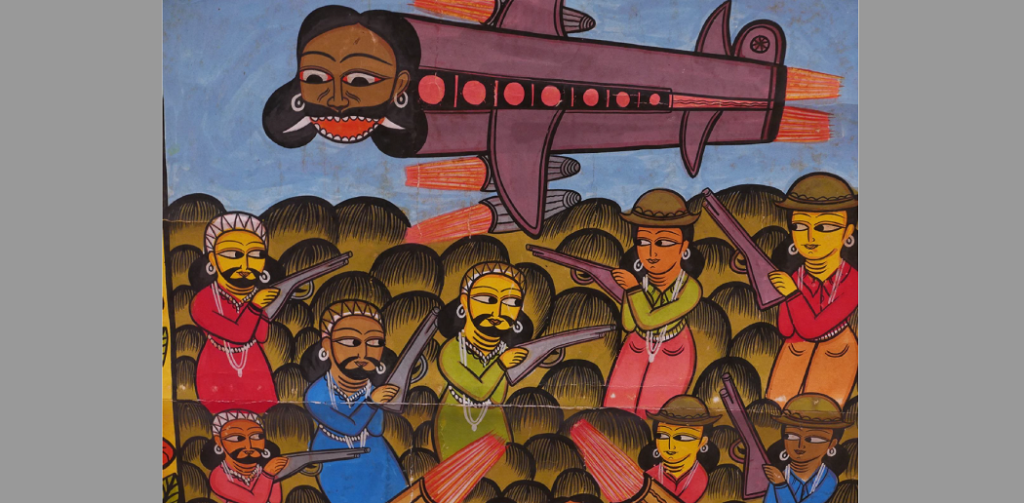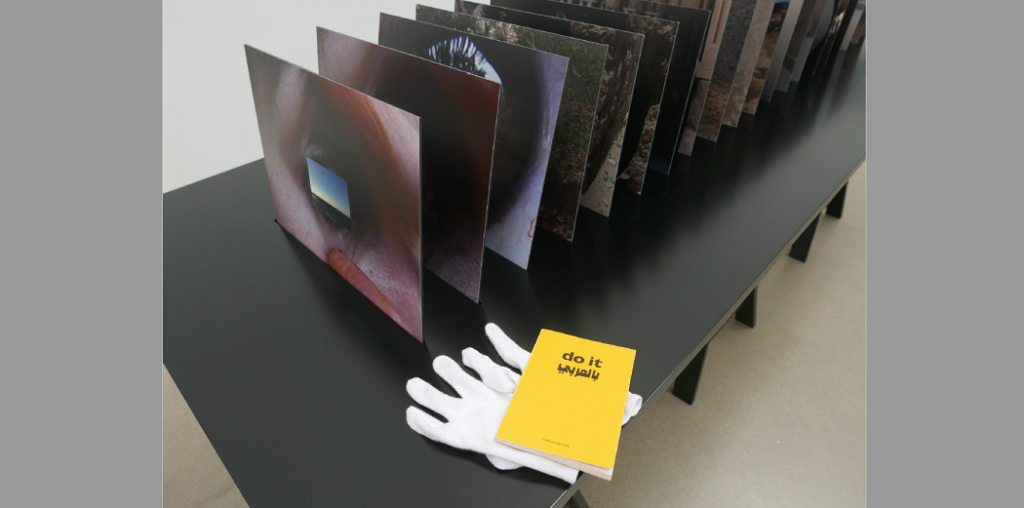A voice (not mine) says something like:
Borders open to an endless moment
It sounds as if the voice is speaking in a large auditorium. The accent is American, although it is hard to pinpoint what region. There was once a recording of this voice, but now it is lost.
It makes him think about Carcross/Tagish curator and writer Candice Hopkins’ channeling of R. Murray Schafer in announcing at the beginning of her talks that ‘We have no earlids’. But what about the earlashes that border our ever-aging ears?
He turns to a book or two to jog his memory. He has two yellow books with the words do it written on the cover in English and Arabic, one is thin and creased, the other is fat and seems barely opened (this one has been signed by ‘the author’, which is somewhat ironic because each page holds a different author’s name!).
There is a text shared by both book which is about an eyelash; more specifically about asking a stranger for an eyelash. Here is a photo of this page in the thinner, more worn book:
And here is a photograph of the same text in the fat, pristine book:
They seem to be the same. But on closer inspection there is a minor difference in the final instruction:
5. Tape the eyelash onto the page of a blank book.
5. Tape the eyelash onto a page of the blank book, found to the left of this text.
The thinner book was accompanied by another, blank book! The minor detail of these two texts’ differences leads him to flick through the pages of the thin book, where he comes across a map of a building.
The text (which would become a book) was positioned outside on a terrace and there was a blank book and some tape next to it. He knows this not because he has seen it himself (although he would visit that same city and stand on that same terrace a few years later at the 14th Sharjah Biennial; fully immersed in its soundscapes), but because he turned back to the fatter book in search of an image. And he found one:
He has so much to say about this image. It appears to be taken at the precise moment that a boy is taping an eyelash to the blank book (was it a stranger’s?) at the same time as behind him a woman is plucking an eyelash from a girl (are they strangers?). However, rather than being satisfied that he has found these decisive moments, he focuses on the fact that the girl has covered her ears with her hands. He thinks to himself: is she covering her ears to prevent this stranger plucking her earlashes?
This peculiar thought takes him right back where he started – to that lost voice. He turns to another book – not yellow, and bigger than the other two.
He flicks through the pages to find an image that he knows accompanies that voice. It takes him some time, but eventually he finds it within an essay called ‘A World Unfolds: The Role of the Vernacular in APT8’ by Abigail Bernal.
As he flips from the image to the beginning of the chapter he pauses at the word ‘vernacular’ and the reproduction of a stunning painting by Warli artist Balu Ladkya Dumada called The God appears in the form of a crane bird, 2010 that spreads across the pages.
He has seen this painting before and not when he saw it for the first time, in person at the 8th Asia Pacific Triennial in Brisbane, but more recently on his computer. It was an image in a pdf of a PowerPoint presentation called ‘To Criticize and to Intervene: Rheim Alkadhi’s Ethics and the Contemporary Classicist’.
This file is all that remains of a talk the talk he delivered at a conference called ‘Classics and the Contemporary’ – there used to be a video of the event at this link, but it is no longer there.
With the book still open on the table under his arms, he scrolls through the images of the pdf of the ppt slides. He knows there must be another way to reproduce them here, but instead he goes the long way round and opens up Paint, pastes screenshots of each page of the pdf, crops them, changes their size to 1050 pixels and saves the image using the name ‘Earlash 1’, ‘Earlash 2’ etc. The slide show below is the result:
Each image takes him back to ATP8 and to his talk in Brisbane. He knew that he didn’t want to deliver his already written talk about ‘the Classical’ in response to the work of Walead Beshty and his Ethics anthology. Instead he went out that morning (with his jet-lag in full swing) to take photos of works in the exhibition that aligned with what he was learning about the idea of the vernacular, not only in terms of the everyday, but also as part of an understanding of Indigenous artistic practices so often dismissed as tribal, craft or folk art. He remembers Wiradjuri artist (and later curator of NIRIN: the 22nd Sydney Biennale) Brook Andrew’s installation Intervening Time, 2015. Little did he know back then that as he was writing this now worlds of Indigenous art would be where he learns from, teaches and engages, far beyond Classics and its ivory tower of Whiteness. He also recalls the still-images that made up the installation by Rheim Alkadhi – the Iraqi-American artist who had created the eyelash instruction piece for Do It, called The Eye Theatre Closes Its Doors and Opens Them Again, 2015 – the focus of his talk then, and his quest (if we can use that archaic, grandiose word) here and now. Turning back to the book, not the thin yellow book that also appeared in the slideshow, or the selection of books that Alkadhi so generously sent him per his request for her own Ethics anthology, but the ATP8 catalogue, he is startled by how the photograph facing Alkadhi’s work shows a group of women formed in a line, holding each other’s arms and covering their own eyes with their hands. (This is a video work by Gabriella and Silvana Mangano called There is no there, 2015.
Once again the sound of the absent, lost voice rushes in across the visual resonance of the covering of eyes here and ears in the other book, whispering something like:
The eye presents as a surface or film, upon which is reflected the outside space of the world.
As a last resort, he turns to his email, where he reads the following two message, the first sent on March 16th, 2016:
Dear Rheim,
I am so sorry to not have replied before now. I’ve had some trouble with my internet connection & I’ve also been running around, jet-lagged & busy! Thank you SO much for your video/recording. You can’t imagine how much it means to me having you (I presume it is you?!) reading the text & showing the images of your piece (with all the movements). In fact, I wanted to ask you, would you be ok with me downloading the video onto my phone & playing it for a (very select) group as they put on the white gloves & perform your piece in the gallery tomorrow after my talk? I completely understand if you’d prefer if I didn’t but I thought that it would be a way of rewarding those people who have endured my talk, giving them a different (if not truly live!) experience of your piece. Do let me know what you think. If not, I am simply happy that I have been able to have this different experience.
By the way, I have changed the title of my talk – it’s now called: To Criticize and to Intervene: Rheim Alkadhi’s Ethics and the Contemporary Classicist. Find attached a pdf of my Power Point slides in case you’re intrigued.
I also met one of the curators here – Tarun Nagesh – & we discussed your work & he shared some articles I’d not seen on your work with me. So, I’m learning all the time!
I hope you are well & enjoying this Classicist’s engagement with your work here in Brisbane! By the way, I keep meaning to ask, where are you right now?
All my best,
Richard
Then the second sent the next day on March 17th, 2016:
Dear Rheim,
How are you? Just a quick note to let you know that I delivered my lecture today – with the re-worked focus on your work. I think it went well. I don’t have a written text – I presented from notes – but at some point I do hope to write it up in some way & if I do, I will of course send you a copy.
Also, as I had not heard from you re: using the recording you gave me to ‘reward’ curious audience members after my talk with a (not truly live) performance of your work, I had initially planned just to give a snippet, so they could get a taste. However, what happened was that only two people followed me upstairs after my talk & so we did a kind of performance of the whole thing, with one person donning the white gloves & me holding the phone for the audio (but not showing the video – except at the moment when you turn your card-board arm!). Both of the people who participated in this were moved & affected by this & expressed how truly happy they were that they could hear your voice with the material images. But at the same time, I did feel somewhat uncomfortable as I’d not heard back from you. So, as a kind of ‘deposit’ against you wishing I hadn’t done this, I took down the names & email addresses of the two people – both are Australian – a man and a woman – I can describe them in more detail if you are interested – in case you wanted to contact them about the performance in some way. Even if it is to reiterate the fact that it was not a true representation of the intention of the work & its conditions etc.
Anyway, it has been an incredible experience encountering your work in this context, juxtaposing it with my engagement with my own field of Classics & thinking through its context here in Brisbane at APT8. I am so grateful to you for engaging with me throughout this – responding to my initial questions, sending texts & the video & generally being open to this weird Classicist’s interest in your work.
I do hope this is just the beginning of something & that we can work together in a more direct way in the future!
All my best,
Richard
He chuckles at his own past self-characterization as a ‘weird Classicist’ as now he is just ‘weird’! Yet even with all of this information and detail flooding back in the sound, the voice, the whisper through the earlashes, remains tantalizingly out of reach. (The video that was shared, on which the sound was heard, is long gone, the WeTransfer inaccessible). All he has left is the vaguest of vibrations, the sense of a low rumble as he flies back and forth, across time and space, arriving here at the conclusion of a thought that lingers about how intimacy, and its resonances, can be possible even within large-scale exhibitions, even when the sound that accompanies an encounter has passed into the air.


